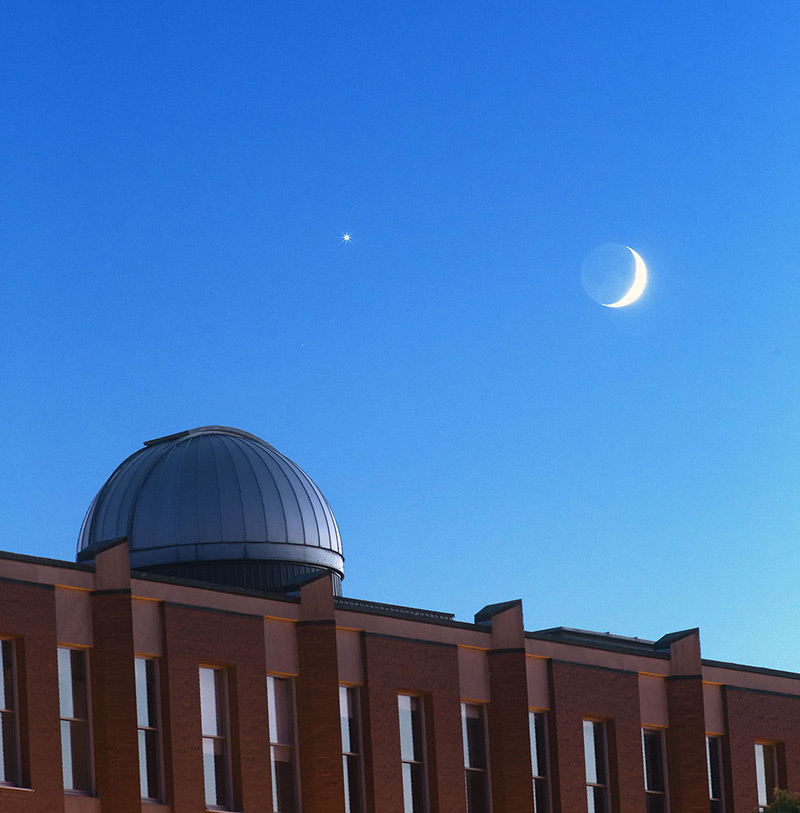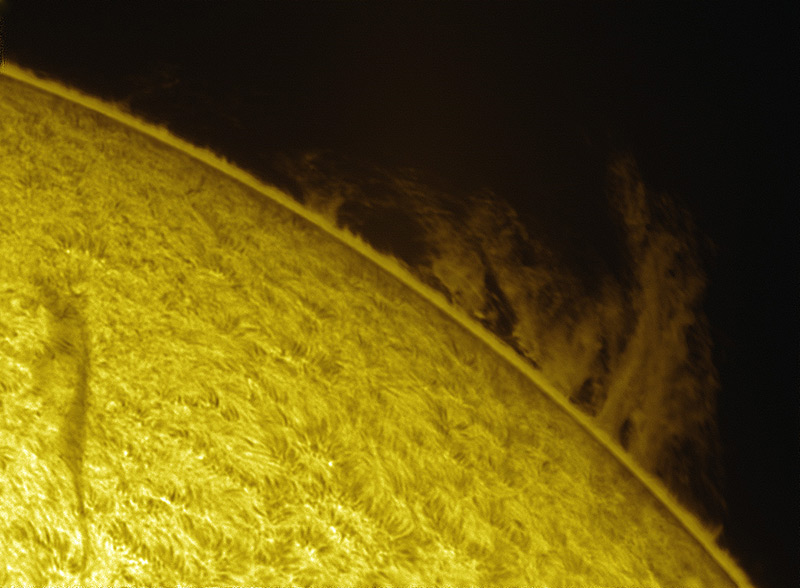Research Areas
Astrophysics
The corrections picked up by GR in the high energy regime may manifest themselves in the cosmic rays produced in highly energetic astrophysical events near black holes, or in gamma-ray bursts in binary systems. The gravitational waves emitted by these astrophysical objects carry with them the signature of the theory. No gravitational wave has been detected directly yet, but the gravitational wave community expects their discovery within the next ten years and the current experimental focus is on astrophysically generated gravitational waves. The detection of gravitational waves and the study of their spectrum, polarization, and speed of propagation would shed light on the correct theory of gravity.
Supernovae of type Ia have been crucial to probe the current acceleration of the universe. However, the progenitors of these supernovae are unknown, a 40-year old problem in astrophysics, and thus it is critical that their origin be determined. The astrophysics of binary stellar systems is the basis for the most plausible models.
Nucleosynthesis. In the standard cosmological scenarios, inflation is followed by an era dominated by radiation in which nuclei of hydrogen, helium, and lithium are synthesized (primordial nucleosynthesis). The relative abundances of these elements, which are measured, must be calculated in extended gravity and compared with observations. Diffusion and other dynamical processes in stellar interiors affect the abundances that will be observed at the surface of old stars. These stellar processes must be understood in order to infer the primordial composition of the universe from the observed composition in stars.
Cosmology
The present universe. Today, cosmologists are struggling to explain the 1998 discovery that the current expansion of the universe is accelerated. This result, obtained by studying the luminosity distance-redshift relation of Type Ia supernovae, does not fit the model of a decelerating universe accepted until 1998. To remain within the context of GR and explain the cosmic acceleration, it is necessary to postulate a mysterious and otherwise undetected dark energy with extremely exotic properties (highly negative pressure) comprising approximately 75% of the energy content of the universe. This dark energy could even take the very exotic form of phantom energy that threatens to violate the second law of thermodynamics cherished by physicists and should be prone to violent instabilities. Phantom energy could cause the universe to end in a Big Rip singularity at a finite future. Several researchers dissatisfied with the ad hoc dark energy are attracted by the idea that perhaps we do not have to introduce this fix and remain within the confines of Einstein’s theory, but the current cosmic acceleration could instead be the first detected deviation of gravity from Einstein’s theory. Attempts to model deviations from general relativity which are successful at explaining the cosmic dynamics without compromising the successes of Einstein theory at smaller scales have resurrected the so-called f(R) gravity theories. While the theories of this class may amount to no more than toy models, they are simple enough to learn how gravity could be different, and yet the deviations from standard relativity are sufficient to show new physics. It is interesting that f(R) gravity can be seen as a special subclass of scalar-tensor gravity, which has been employed widely in cosmology.
The early universe. Modified gravity models different from those studied to explain the present acceleration of the universe are employed to study the early universe. In fact, although it is not widely acknowledged, many models of the early universe are based on forms of scalar-tensor gravity (for example, scalar fields coupled conformally or non-minimally to the curvature, and there are indications that non-minimal couplings are mandatory). A period of accelerated inflation in the early universe is postulated in modern cosmology and is widely accepted as an essential ingredient of our description of the universe (although we should be open to other possibilities). High energy corrections to gravity affect this inflationary epoch and would likely leave an imprint in quantities that are observable today in the cosmic microwave background.
Spherical solutions and black holes. Spherically symmetric solutions of scalar-tensor and f(R) gravity, which are essential to understand black holes, compact objects, and their astrophysics exhibit a much larger variety of properties than in general relativity and their study is just beginning. We study how Birkhoff’s theorem of general relativity (which guarantees that a unique and simple solution with spherical symmetry, the Schwarzschild metric exists and is generic in vacuo) fails in extended gravity. We search for new solutions and we look at the possibility of identifying “generic”‘ (in a sense to be made mathematically precise) solutions, if they exist. A feature of the theories of gravity designed to model the present acceleration of the universe is that they contain a time-dependent effective cosmological “constant”. As a result, solutions describing black holes or spherical objects are asymptotically Friedmann-Lemaitre-Robertson-Walker and they are dynamical. Very little is known, even in general relativity, about black holes embedded in a cosmological background. We are presently studying a few analytical solutions and looking for new ones. Instead of black hole event horizons, there are apparent horizons which often exhibit a bizarre phenomenology to be understood. The accretion of the cosmological fluid onto the central object complicates the picture. Entropic and thermodynamical aspects of black holes, a large area of research in general relativity and quantum gravity, are very interesting also in extended gravity in order to grasp the physical characteristics of these theories. Black holes embedded in cosmological backgrounds provide realizations of dynamical horizons, which are actively studied by people working in black hole thermodynamics. Black holes constitute “theoretical laboratories” to study high energy physics which is not accessible by experiments.
Gravitational waves. Primordial gravitational waves generated during the early epochs of the history of the universe carry a signature of the theory of gravity which may be detectable as an imprint in the cosmic microwave background. If extracted from the data, this signature could be used to discriminate between, or set constraints on, competing theories of gravity using future satellite experiments. Cosmological gravitational waves may also induce scintillation in the light received from sources at cosmological distances. A preliminary study yields a size below detection threshold for this effect, but a more definitive analysis needs to be carried out.
Fundamental theories of gravity
Alternative gravity. The “standard” theory of gravity is naively believed to be Einstein’s general relativity. However, when one tries to formulate a quantum version of classical gravity, as has been done for the other three fundamental interactions, or at least to introduce first loop corrections to the classical theory, a different picture emerges. The renormalization of general relativity shows that infinities cannot be eliminated without introducing counterterms quadratic in the curvature tensor and its invariants, which modify substantially this theory. Vice-versa, starting from the high energy end, one can consider string theories as possible implementations of quantum gravity and of unification. When one tries to take the low-energy limit of string theories and recover classical gravity, one does not obtain general relativity, but a scalar-tensor theory. Indeed, it has been known since the 1980s that the low-energy limit of the bosonic string theory (one of the earliest and simplest string theories) reproduces Brans-Dicke theory with Brans-Dicke parameter ?= -1. String theories unavoidably contain scalar fields which couple non-minimally to gravity. From the theoretical point of view, quantization of gravity and high energy physics seem to necessarily modify general relativity, generating a wide spectrum of extended theories which deviate only a little from general relativity at low energy and Solar System scales, but exhibit large deviations at higher energy. These deviations can in principle manifest their effects also at cosmological scales, or maybe even at spatial scales intermediate between Solar System scales (where general relativity is well tested and known to be obeyed in the weak-field, small velocity regime) and cosmological scales. These are the scales of galaxies and galaxy clusters. Note that at these scales even Newtonian gravity is sometimes doubted, which has led to the introduction of modified gravity, MOND and TeVeS theories as an alternative to dark matter. While we do not support these theories, they show how poorly even Newtonian gravity is tested outside the Solar System. Although the quantum corrections to general relativity may be tiny at low energies and no departure from it is detected in the Solar System, there may be indications of deviations from Einstein’s theory in cosmology.
© 2012-2019 Stellar Astrophysics and Relativity Research Cluster
Bishop's University - All Rights Reserved

Bishop's University
2600 College Street
Sherbrooke, QC, Canada
J1M 1Z7
Tel: 819 822-9600
Fax: 819 822-9661


